Hickory trees belong to the walnut family (Juglandaceae) and are in the plant genus Carya. Hickory trees are prized for their hard, dense wood, large delicious nuts, and sweet syrupy sap. Hickory trees are common in temperate rainforests in North America and some parts of Asia.
Hickory trees are large to medium deciduous trees with dense foliage and a spreading canopy. All hickories reach heights of 50 to 100 feet at maturity with a spread of roughly 40 feet and live for many years. Unless grown commercially, most hickories do not grow in stands but appear individually scattered across a wide area among other trees such as maples, oaks and pines. Hickory trees have ridged, gray flakey bark, leaves with serrated edges, and egg-shaped nuts.
The nuts from all hickory trees are encased in hard shells that plummet down from the branches in the fall. Hickory nuts ripen in late summer and early autumn. Once the husks darken in color and begin to split at the base, the seeds inside are mature and ready to germinate. Hickory trees are also grown for shade, for their hard wood, and as a habitat for birds and other small animals.
Hickories propagate most reliably from seeds, which must be harvested in late summer and planted while still fresh. The seeds require thorough soaking and cold stratification to successfully germinate, but will sprout quickly once exposed to consistently warm and moist conditions.
- Shagbark Hickory (Carya ovata)
- Shellbark Hickory (Carya laciniosa)
- Pignut Hickory (Carya glabra)
- Mockernut Hickory (Carya tomentosa)
- Bitternut Hickory (Carya cordiformis)
- Scrub Hickory (Carya floridana)
- Sand Hickory (Carya pallida)
- Red Hickory (Carya glabra)
- Nutmeg Hickory (Carya myristiciformis)
- Black Hickory (Carya texana)
- Pecan Tree (Carya illinoinensis)
- Southern Shagbark Hickory (Carya carolinae-septentrionalis)
- Mexican Hickory (Carya palmeri)
- Water hickory (Carya aquatica)
- Vietnam Hickory (Carya tonkinensi)
- Chinese Hickory (Carya cathayensis)
Shagbark Hickory
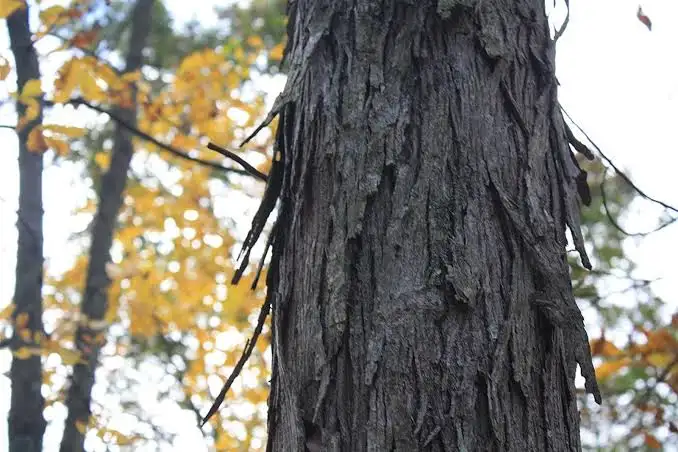
Shagbark hickory’s most prominent ornamental feature is its unique, smoke-gray bark that warps away from the stem in foot-long plates. The edges of long plates of bark curl away from the trunk, giving this tree a very rugged appearance. Shagbark hickory is beautiful when its winter buds open in late spring; the bud scales fold back, petal-like, as new foliage emerges. This hickory offers lightly hung, downy foliage that casts medium shade in summer. An added attraction for this tree is the delicious edible nut it bears.
Shellbark Hickory
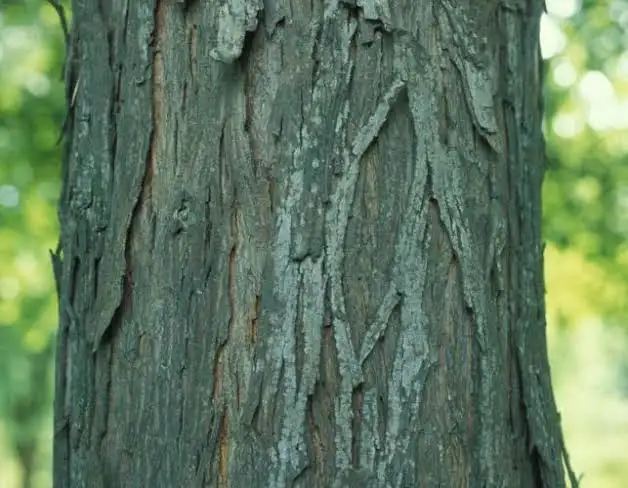
Shellbark hickory is similar to the pignut and shagbark hickories. It is characterized by a high-branching tree with a straight, slender trunk and a narrow, oblong crown. They usually have 7 to 9 leaflets with a terminal leaflet somewhat larger than its lateral leaflets. This is a slow-growing tree often found on deep bottomland soils near rivers and creeks. It is also more resistant to forest pests and pathogens than other hickories. The shellbark hickory is sometimes also called king nut hickory because its nuts are the largest of all the hickories.
Also Read: Different Types of Walnut Trees For Your Home
Pignut Hickory
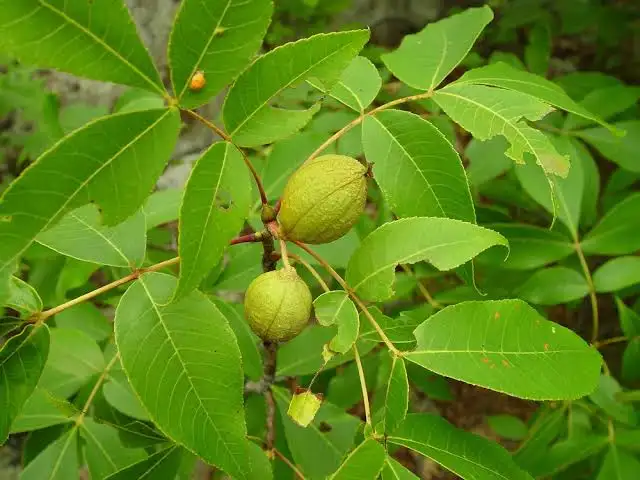
The pignut hickory offers lightly hung foliage in summer that casts a medium shade. In winter its open habit and bark are of interest. The hickory is particularly beautiful when winter buds open in late spring; the bud scales fold back, petal-like, as new foliage emerges. Pignut hickory is best planted in a park-like area where its large size, leaf litter, fruit and twig drop will not be problems. Its savory nuts attract squirrels and other animals that may be unwanted in residential areas.
Mockernut Hickory
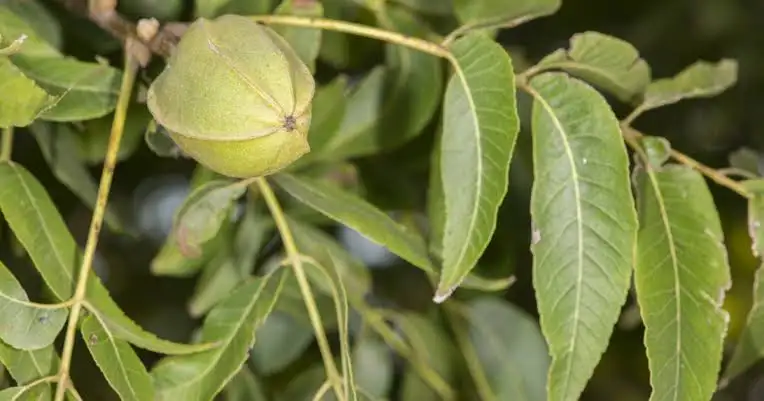
Mockernut hickory also referred to as white hickory, whiteheart hickory is a medium to large tree 50-100 feet tall, consisting of a straight trunk and an oblongoid crown with spreading branches. In densely wooded areas, the lower half of the trunk is devoid of branches, while in open areas the crown of this tree extends to a lower level. Trunk bark of mature trees is gray to dark gray and relatively coarse, consisting of forking or intertwining ridges that are somewhat irregular. These ridges are separated by gray to reddish brown furrows. The bark of branches is gray and more smooth, while twigs are gray to grayish brown and relatively stout. Young shoots are light green, light brown, or brown, densely pubescent, and relatively stout.
Bitternut Hickory
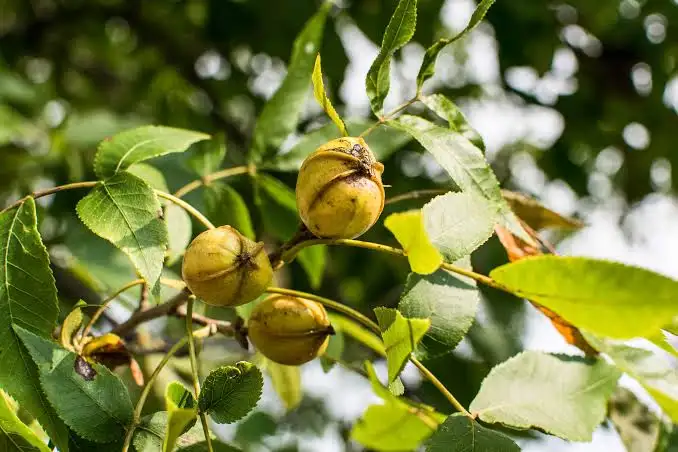
Bitternut hickory is s a medium sized tree becoming rounded with age. It’s distinguished by its smooth bark and sulfur-yellow buds. The pinnate leaves typically have 5-9 bright-green leaflets that turn yellow in the fall. As its common name implies, this tree produces a bitter tasting nut. When surrounded by other trees, the trunk is long and straight and the crown is short; in open areas, the trunk is less long and the crown larger and ovoid in shape. At all seasons, the Bitternut Hickory can be identified from all other native trees by its long, scaly, yellow buds. On bottomlands, it develops into a tree of 50 to 70 feet or more with a straight trunk, 1 to 2 1/2 feet in diameter. The wood is hard and heavy, but useful for making many types of furniture, paneling, and tools.
Also Read: Major Types of Cypress Trees For Your Home
Scrub Hickory
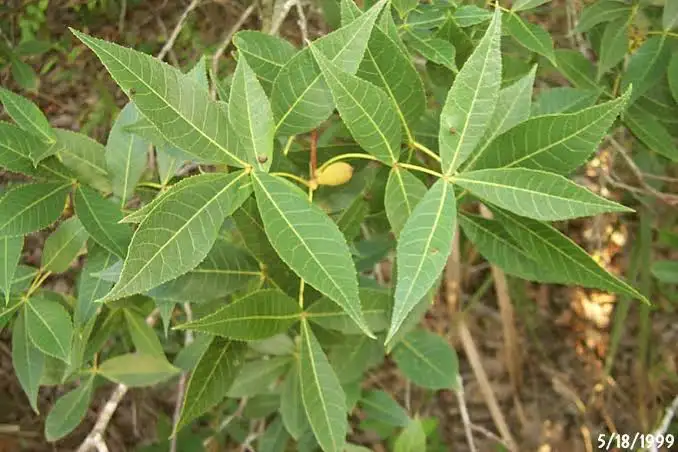
Scrub hickories are tree-shrubs that may only reach 16 ft. (5 m) tall. However, some scrub hickory trees can grow up to 80 ft. (25 m) tall. These small hickory trees have 12″ (30 cm) leaves with seven broad pointed leaflets. Scrub hickories produce small edible drupes. Scrub hickory got its botanical name Carya floridana as this tree is native to Southeast United States, and is endemic in central Florida.
Sand Hickory
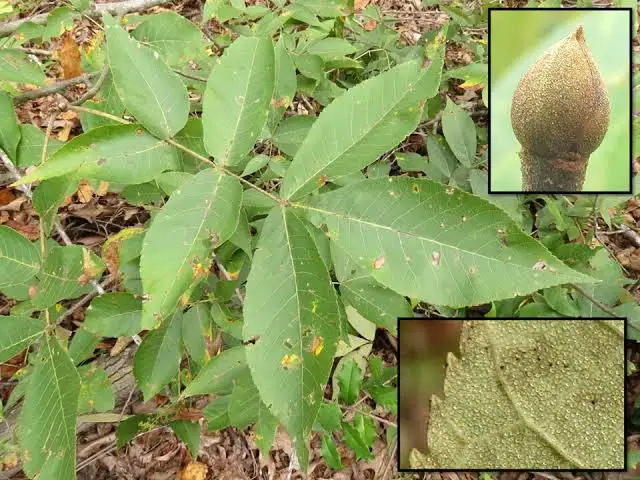
Sand hickory trees have smooth bark with shallow furrowing in a network-type pattern. Sand hickories are slow-growing deciduous trees, growing up to 80 ft. (24 m). The characteristics of sand hickory trees are shiny pinnate leaves with pointed leaflets and small edible drupes.
Red Hickory
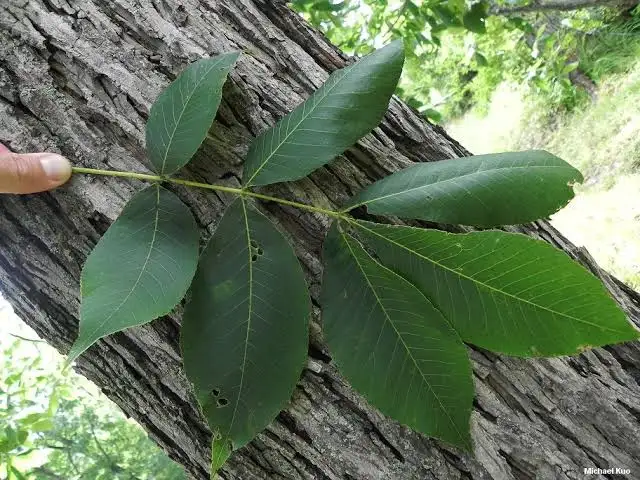
The red hickory is generally encountered as a medium-sized tree, capable of growing to 30 m (100 ft) in height. The single trunk is straight and often continues for the entire height of the tree, although sometimes splits into several large limbs once the canopy has been breached. The branches are strong, stout and long, ascending in the upper crown and drooping in the lower crown; the branches around mid-height are more or less horizontal. This creates a broad, thick, column-shaped form that casts dense shade. Individuals have been known to live from 100–250 years of age.
Also Read: Different Types of Poplar Trees For Landscaping
Nutmeg Hickory
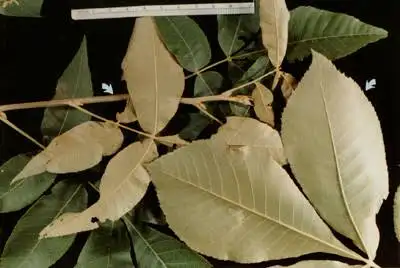
Black hickory is a small to medium tree with short, crooked branches and a narrow crown. This tree is 30–60 feet tall forming a trunk up to 2 feet across and a variably shaped crown. Bark is dark gray to black, tight, not scaly, with irregular blocky ridges and deep furrows. Twigs are slender, often crooked, tapering abruptly to the terminal bud. Young twigs and terminal buds have fuzzy, rusty scales. Nutmeg hickory grows on a variety of loamy, silty, or clayey soils that may be described as moist, but well or moderately well drained and amply supplied with mineral nutrients. The species most often is found in minor stream bottoms, on second bottom flats, and on slopes or bluffs near streams.
Black Hickory

Black hickory is a small to medium tree with short, crooked branches and a narrow crown. This tree is 30–60 feet tall (rarely taller than that), forming a trunk up to 2 feet across and a variably shaped crown. The Trunk bark of mature trees is dark gray or brownish gray, coarsely rough-textured, and irregularly furrowed with interrupted ridges; sometimes trunk bark is divided into plates and appears blocky. The bark of branches is gray or brownish gray and less rough-textured, while the twigs are mostly brown with white lenticels. Young twigs earlier in the year are often sparsely covered with powdery yellow or rust-colored scales, but they become glabrous later.
Pecan Tree
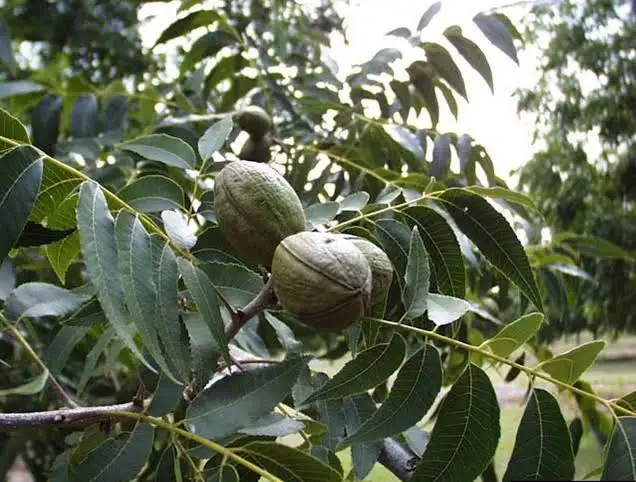
Open grown pecan trees have massive trunks and oval or rounded wide spreading crowns of branches that extend far down the trunk. Forest trees have a straight trunk and compact, pyramidal crowns. Pecan trees shed flowers, leaves, and branches, which some people consider to be too messy. Pecan trees are large with a spread of up to 75 feet, and grow up to 130 feet tall. They have an up-to 7-foot trunk diameter. The pinnate pecan leaves grow alternately on branches. Each leaf is 2 to 4 inches long, and about an inch wide. The tree grows a long taproot with feeder roots that reach deeper than 10 feet below the ground.
Also Read: Different Types of Ash Trees
Southern Shagbark Hickory
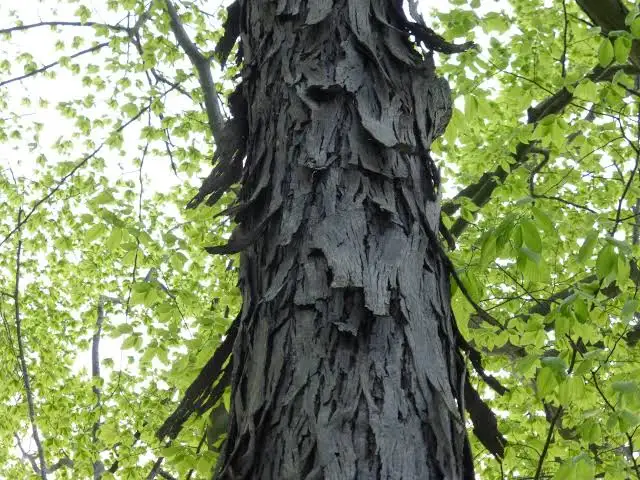
Southern shagbark hickory is considered by some to be merely a variety of C. ovata, rather than an independent species. It is a small to medium tree with short, crooked branches and a narrow crown. Southern Shagbark hickory trees derive their unique name from the interesting peeling bark they bear. Strips of the tree’s exterior will jut out from one or both ends, curling outward and providing the trunk with a lot of texture. The Southern shagbark hickory grows primarily in the southeastern states in areas where large deposits of limestone are found.
Water Hickory
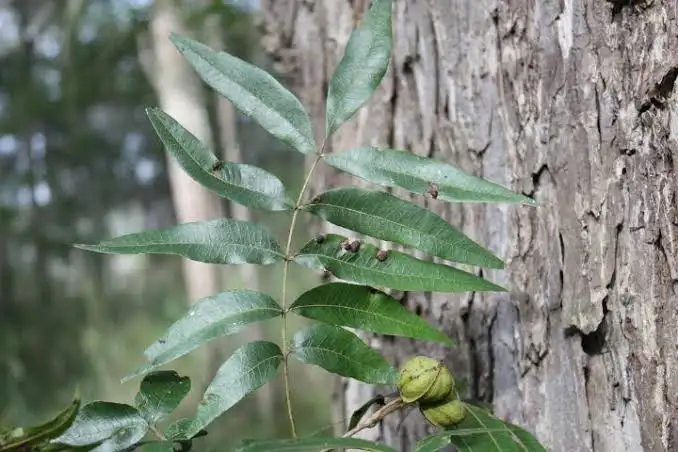
Water hickory (Carya aquatica) is a major constituent of clay flats and backwater areas near streams and rivers of the South. This is a large tree, that can grow over 30 metres (98 ft) tall. Also known as bitter pecan, the species reproduces aggressively from both seed and sprouts. This tree species is tolerant of wet soils but grows best on well draining soils near rivers and other water ways. Bark is dark gray to black, tight, not scaly, with irregular blocky ridges and deep furrows. Twigs are slender, often crooked, tapering abruptly to the terminal bud. Young twigs and terminal buds have fuzzy, rusty scales.
Mexican hickory
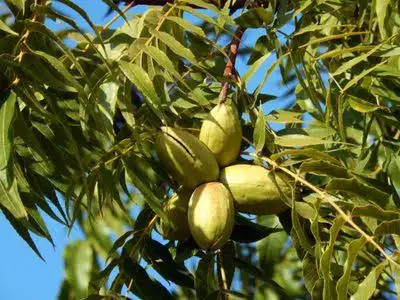
Carya palmeri, the Mexican hickory, is a tree species native to Mexico.It was first described by Jacob Warren Manning to be a member of Genus Carya based on leaves, flowers, fruits and wood of the tree. The Mexican hickory tree has brownish-gray bark that tends to peel in plates. These hickories have shiny green leaves with a silvery underside. The round nutshells are reddish-brown with patterns resembling nutmegs, and their kernels are mild sweet. Mexican hickories grow up to 100 ft. (30 m) and are only found growing in scattered populations in some of the southern states.
Also Read: Fast Growing Trees You Need To Know
Vietnamese Hickory

Vietnam hickory is a deciduous tree with smooth, tight, grayish bark. Current season shoots terminate in a cluster of bright orange leaf buds, whose color is due to abundant orange peltate scales. There are no bud scales. Leaves are odd pinnately compound and up to 38 cm long including the petioles. Petioles are densely hairy with very short hairs. There are usually 5-7 leaflets. Lateral leaflets are opposite, ovate-lanceolate to oblanceolate, acuminate, subrounded to cuneate at the base, and simply serrate. The terminal leaflet and first pair of lateral leaflets are larger than basipetal leaflets. Leaflets have reddish-orange peltate scales on the abaxial surface and are puberulous along the midrib. The adaxial midrib is puberulous.
Fastest Growing Hickory Tree
Hickory trees are categorised into two groups, that is: true hickories and pecan hickories, all of which are distinguished by the number of leaflets on each leaf. All hickory trees are slow-growing, but can live for hundreds of years. The fastest growing true hickory is the shagbark hickory (Carya ovata) and the fastest growing pecan hickory is the pecan (Carya illinoensis). The pecan is the fastest growing of all hickory species, though still slower than other hardwoods.
What is the Difference Between Shagbark and Shellbark Hickory Trees?
Shagbark grows to heights of 70 to 90 feet, and shellbark to between 60 and 80. Shagbark hickories, though they are taller, have slightly narrower trunks, maturing to 2 or 3 feet as opposed to 3 or 4 for shellbark hickories. Both trees have odd-pinnate compound leaves growing in groups of between five and nine, but usually seven. The leaflets are similar in appearance on both trees and turn golden-brown in fall.
The shagbark hickory has smooth, gray bark when young, but it starts to exfoliate and shed off the tree in strips as the tree ages. Although its bark looks similar, and almost the same when younger, the shellbark hickory has smoother bark when older, with less pronounced shredding than shagbark. The shellbark hickory is sometimes also called king nut hickory because its nuts are the largest of all the hickories.
Further References
- Elias, Thomas S. 1972. The genera of Juglandaceae in the southeastern United States. Journal of Arnold Arboretum 53:26-51.
- Eyre, F. H., ed. 1980. Forest cover types of the United States and Canada. Society of American Foresters, Washington, DC. 148 p.
- Hepting, George H. 1971. Diseases of forest and shade trees of the United States. U.S. Department of Agriculture, Agriculture Handbook 386. Washington, DC. 658 p.
- Johnson, Robert L. 1975. Natural regeneration and development of Nuttall oak and associated species. USDA Forest Service, Research Paper SO-104. Southern Forest Experiment Station, New Orleans, LA. 12 p.
- Johnson, R. L., and W. R. Beaufait. 1965. Water hickory (Carya aquatica (Michx. f.) Nutt.). In Silvics of forest trees of the United States. p. 136-138. H. A. Fowells, comp. U.S. Department of Agriculture, Agriculture Handbook 271. Washington, DC.
- Nelson, Thomas C. 1965. Silvical characteristics of the commercial hickories. USDA Forest Service, Hickory Task Force Report 10. Southeastern Forest Experiment Station, Asheville, NC. 16 p.
- Putnam, John A., and W. M. Broadfoot. 1965. Maximum potential total yields of normal stands of southern hardwoods by species groups and site classes. USDA Forest Service, Southern Forest Experiment Station. Unpublished report on file at Southern Hardwoods Laboratory, Stoneville, MS. 11 p.
- Rousseau, R. J., and Bart A. Thielges. 1977. Analysis of natural populations of pecan, water hickory, and their hybrid, bitter pecan. In Proceedings, Central States Tenth Forest Tree Improvement Conference. p. 1-8. Purdue University, Department of Forestry and Natural Resources, West Lafayette, IN.